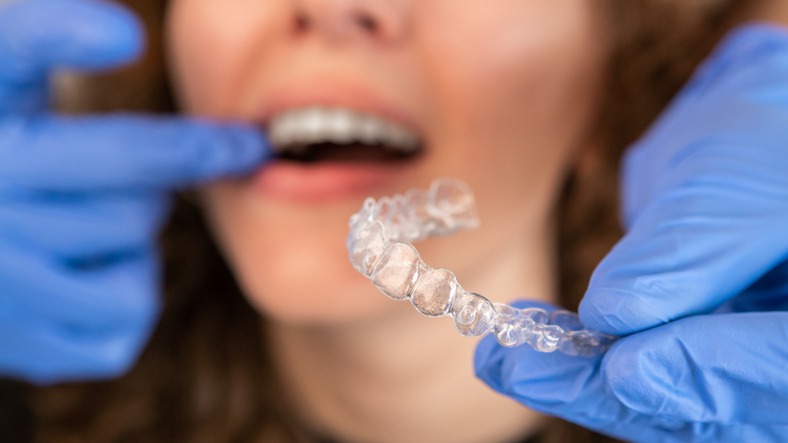When you think of Botox, the first thing that might pop into your head could be wrinkle treatment. But did you know that Botox has found a prominent place in dental offices as well? If you’re considering Botox for any number of dental or facial concerns, you might be wondering what the process will be like. We’ll walk you through what to expect during your dental Botox treatment, easing any concerns you might have before you sit in the dentist’s chair.
Therapeutic Applications of Botox in Dentistry
Botox in the dental field can be intriguing. It’s more than just a cosmetic quick fix; it’s also used to address issues like TMJ (temporomandibular joint disorders), bruxism (teeth grinding), and even for adjusting to new dentures. Botox is a purified protein that, when injected, temporarily relaxes muscles by blocking nerve signals.
Getting Botox at your dentist makes a lot of sense. Who knows the facial anatomy better than a dentist? Plus, they’re already pros at giving injections in and around the mouth. So, if you’re on the hunt for botox in Dallas, your dentist is the provider you need.
Before the Treatment
Your journey with Botox begins well before the actual injections. You’ll have a detailed discussion with your dentist about your concerns and what you hope to achieve with the treatment. They’ll explain how Botox works, go over your medical history, and discuss any potential side effects.
Consultation and Goals
First things first, you’ll chat with your dentist about why you’re considering Botox. It’s the perfect time to ask questions and state your objectives, whether you’re looking to alleviate pain, improve the aesthetics of your smile, or both.
Medical History Review
Your dentist will review your entire medical history to ensure Botox is a safe option for you. They’ll need to know about any medications you’re taking, allergies you might have, and your overall health status.
Expectations and Side Effects
Your dentist will also set realistic expectations for the treatment’s outcomes. They should be transparent about what Botox can and can’t do for you. Side effects are typically minimal but can include bruising, swelling, or redness at the injection site.
The Day of Your Treatment
When the big day arrives, you might feel a mix of excitement and nerves. Here’s what you’ll typically go through during the appointment:
The Procedure
-
You’ll be seated in a comfortable chair, much like you would for a regular dental exam.
-
The areas for injection will be cleaned, and sometimes a topical anesthetic will be applied, although many find the injections to cause minimal discomfort.
-
Your dentist will use a fine needle to inject Botox into the targeted muscles. This process usually only takes a few minutes.
-
After the injections, you’ll receive aftercare instructions to get the most out of your treatment.
Remember, Botox is not an immediate fix—it usually takes a few days to see the full effects.
Aftercare Guidelines
Right after your Botox injections, you’ll need to follow a few simple aftercare steps to ensure the best results and reduce the chance of any complications:
-
Avoid touching or massaging the treated areas for at least 24 hours to prevent spreading the Botox to nearby muscles.
-
Stay upright for several hours post-treatment; no naps directly after your appointment.
-
Abstain from rigorous exercise for a day to reduce the risk of bruising.
Managing Side Effects
If you do experience side effects such as bruising or swelling, they’re usually minor and resolve quickly. Your dentist might recommend applying a cold compress to the affected area to reduce discomfort.
Post-Treatment Expectations
After your dental Botox treatment, it’s essential to keep an eye on the results and any adverse reactions that might occur. Typically, you can return to your everyday activities right away, though you should be mindful of the aftercare instructions.
Seeing Results
It’s important to note that Botox results take time to show up. It may take several days to a week for you to see the change. Patience is key here. The effects of Botox are temporary, often lasting for about 3-4 months. You’ll need follow-up treatments to maintain the results.
Follow-Up Appointments
Your dentist will likely schedule a follow-up visit to check on your progress. This appointment is crucial to monitor how your face is responding to the treatment and adjust the plan if necessary. Plus, it gives you a chance to discuss any concerns you may have as the Botox takes effect.
Finding the Right Botox Provider
Not all providers are created equal, especially when it comes to something as delicate as facial treatments. If you’re deciding on a Botox provider, consider the following:
-
Qualifications and Experience: Make sure your provider is not only qualified but experienced in facial anatomy and Botox treatments.
-
Before and After Photos: A picture is worth a thousand words. Look at before and after photos of previous patients to gauge the provider’s work.
-
Patient Reviews: Check testimonials and reviews from other patients. A solid track record can give you peace of mind.
And remember, your go-to dental care provider might be the right person for the job. They know your dental history your facial structure, and they have the expertise in delivering precise injections.
Final Thoughts
Dental Botox is increasingly used for teeth and facial issues. It’s okay to be curious and careful. Learning what it involves, discussing goals and health, and knowing aftercare eases worries. Always pick a qualified dentist, stick to care tips, and communicate for a good experience and a confident smile.





